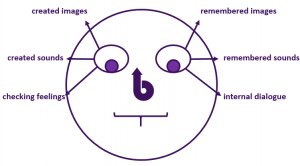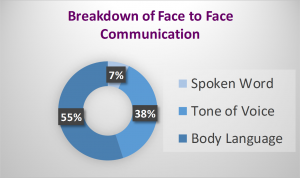You may not play poker, but you probably have a tell.
When I tell people that I graduated in psychology, I am invariably met with the question “Oh no! Are you reading my body language?”. So there is a general awareness that non-verbal communication is a component of the behavioural sciences. However, you do not need to be a psychologist to understand body language, far from it. You and everyone you know is interpreting body language all day long and making frequent inferences from it.
Body language is just one form of non-verbal communication. There are many components, such as: tone of voice, volume of voice, position of body, gesticulations, eye movements, perspiration, body movements, vocal pauses and so on. All of these impact the perception of the words you say. Your style of delivery impacts whether people trust what you say, or moreover, it impacts whether they even listen to the words.
If you have ever watched yourself presenting on video, you have probably cringed or been surprised by some of your facial expressions. Things that you perhaps thought went unnoticed, are more obvious than you think.
 Ask a poker player if a person’s face can reveal their true thoughts, they will answer that everyone has a ‘tell’. Everyone has an eye movement, face touch or expression that indicates they are bluffing. There are many studies that have been performed over the years. Some have unearthed some quite detailed tells. For instance, the movement of your eyes following a question can indicate whether you are recalling the answer or constructing one. If you ask someone what their boss asked them to do and they look straight to the left. The theory suggests that they are recalling what was said to them. If, however, they look to the right, the model suggests that maybe they are making up an instruction (right handed people). Commentators such as Rhoads and Solomon quoted reliability figures as high as 90% when using this model to detect lying. However, other researchers have been more sceptical in their analysis. Suffice to say that Neuro Linguistic Programming research has unearthed a direct link between eye movement and information recall and construction. While this is interesting, it does not prove hugely useful to those in general leadership roles. However, if you frequently perform incident investigations and are trained in taking witness statements, some further reading and practise of this technique could be useful. However, remember, a conclusion based solely on this model is not likely to hold water.
Ask a poker player if a person’s face can reveal their true thoughts, they will answer that everyone has a ‘tell’. Everyone has an eye movement, face touch or expression that indicates they are bluffing. There are many studies that have been performed over the years. Some have unearthed some quite detailed tells. For instance, the movement of your eyes following a question can indicate whether you are recalling the answer or constructing one. If you ask someone what their boss asked them to do and they look straight to the left. The theory suggests that they are recalling what was said to them. If, however, they look to the right, the model suggests that maybe they are making up an instruction (right handed people). Commentators such as Rhoads and Solomon quoted reliability figures as high as 90% when using this model to detect lying. However, other researchers have been more sceptical in their analysis. Suffice to say that Neuro Linguistic Programming research has unearthed a direct link between eye movement and information recall and construction. While this is interesting, it does not prove hugely useful to those in general leadership roles. However, if you frequently perform incident investigations and are trained in taking witness statements, some further reading and practise of this technique could be useful. However, remember, a conclusion based solely on this model is not likely to hold water.
You may have been told that only 7% of what we communicate is the words we say. Think again, if this was the case I don’t think the telephone would have taken off like it did!
For everyone else, what is the significance of body language in the work place? Mehrabian and Mehrabian & Ferris have conducted a number of experiments, the results of which are pretty well publicised in leadership training. They conducted experiments to explore the impact of non verbal communication and how this influenced the spoken message. They found that when conveying emotion, the tone of voice and body language had more of an impact on  communication than the words themselves. Using a number of studies they quantified this effect. They found that when conveying emotion only 7% of the message is conveyed in words, 38% is conveyed in tone and 55% is conveyed by body language. This is very often misconstrued to mean that only 7% of what we communicate is in the words. This is not the case. However, this does not make the finding any less useful. When communicating face-to-face, the listener or receiver is monitoring our body language and tone as much as our words. If communicating emotion, these aspects have more influence than the words. So what does this tell us? Firstly, and something particularly pertinent in the email age, communications that consist purely of words can easily be misconstrued. Especially if they attempt to convey emotion. This is because, research shows us that we rely heavily on non-verbal communication to receive a message. When this element is removed, we often struggle. Especially if the written message is trying to convey feelings, a sense of urgency or humour.
communication than the words themselves. Using a number of studies they quantified this effect. They found that when conveying emotion only 7% of the message is conveyed in words, 38% is conveyed in tone and 55% is conveyed by body language. This is very often misconstrued to mean that only 7% of what we communicate is in the words. This is not the case. However, this does not make the finding any less useful. When communicating face-to-face, the listener or receiver is monitoring our body language and tone as much as our words. If communicating emotion, these aspects have more influence than the words. So what does this tell us? Firstly, and something particularly pertinent in the email age, communications that consist purely of words can easily be misconstrued. Especially if they attempt to convey emotion. This is because, research shows us that we rely heavily on non-verbal communication to receive a message. When this element is removed, we often struggle. Especially if the written message is trying to convey feelings, a sense of urgency or humour.
Furthermore, when we deliver face-to-face communications, we should also be aware of how our non-verbal communication can effect the authenticity of our message. If we are communicating an exciting new business venture that our company is embarking upon, but we are not really sold on the idea, then our tone and body language may send the wrong message entirely. Never think that because the words we say are positive then we are delivering a positive message. The human audience is far more sophisticated than that.
This post is not about learning that pointing your feet towards the door means you want to leave the conversation, or crossing your arms indicates that you are being defensive. This is about awareness. Be aware that your body language and tone communicate your emotion more than your words. Tell someone you are happy with a dead-pan face and a sarcastic tone and the words take on a completely different meaning. So when you wish to communicate a message, think about your posture, think about your tone before you embark on the communication. Think whether you should be seated or standing, will you be wearing a jacket or cardigan, will you walk around or stand still? Plan these things rather than leave them to chance. Think also about the tone of voice you will use. Soft tones or strongly spoken, jubilant or sombre? Simply by being aware of this, your communications will improve.
 Visualise how you wish to appear, think about those keynote speeches you have seen at conferences, how impressive were they, do you want to be like that? Now think about some poor presentations you have sat through, was it the words that were wrong or the delivery? Practise your tone and your body language. Ask your colleagues, do you have a tell? Do you have a repeated body movement that shows when you are lying or are not committed to your message? If so, work on it, practise masking your tell.
Visualise how you wish to appear, think about those keynote speeches you have seen at conferences, how impressive were they, do you want to be like that? Now think about some poor presentations you have sat through, was it the words that were wrong or the delivery? Practise your tone and your body language. Ask your colleagues, do you have a tell? Do you have a repeated body movement that shows when you are lying or are not committed to your message? If so, work on it, practise masking your tell.
A few bullets to help you:
- Don’t use written communication for potentially emotional messages. Keep these for facts and figures.
- When people can’t see the presenter, words can be misunderstood. Check the room layout for large audiences, go for video over audio conferences.
- Your body language may convey your true feelings rather than the agreed message. Practise at home with your partner or friends.
- When people don’t properly understand the words they will rely heavily on non-verbal communication. Check your language is appropriate for your audience.
- We pay more attention to non-verbal communication when the presenter is unfamiliar to us and we are yet to establish trust. Bare this in mind when you have an unfamiliar audience.
- If we suspect someone is lying, we automatically concentrate more on body language.
- Skew your message to suit your objective. If you want someone to pay more attention to your non-verbal communication, make the words more vague or ambiguous. If you want someone to focus on your words, keep them simple and factual.
We may never be as polished as the key note speaker at that international conference, but by focussing on our non-verbal communication we can greatly improve our communication effectiveness. Remember, the Mehrabian split only applies to face to face communication of emotion. Do not focus on that 7% and believe your words aren’t important. The words we say are crucially important, our non-verbal communication helps ensure they are interpreted correctly.
